Deck 26: Lipids
Question
Question
Question
Question
Question
Question
Question
Question
Question
Question
Question
Question
Question
Question
Question
Question
Question
Question
Question
Question
Question
Question
Question
Question
Question
Question
Question
Question
Question
Question
Question
Question
Question
Question
Question
Question
Question
Question
Question
Question
Question
Question
Question
Question
Question
Question
Question
Question
Question
Question
Question
Question
Question
Question
Question
Question
Question
Question
Question
Question
Question
Question
Question
Question
Question
Question
Question
Question
Question
Question
Question
Question
Question
Question
Question
Question
Question
Question
Question
Question

Unlock Deck
Sign up to unlock the cards in this deck!
Unlock Deck
Unlock Deck
1/123
Play
Full screen (f)
Deck 26: Lipids
1
______________ is produced by the Brazilian palm tree and is commonly used in polish formulations for boats and cars.
A) Oil
B) Lanolin
C) Spermaceti
D) Carnauba wax
E) Beeswax
A) Oil
B) Lanolin
C) Spermaceti
D) Carnauba wax
E) Beeswax
Carnauba wax
2
Which of the following statements is (are) true about lipids?
A) Lipids are soluble in nonpolar organic solvents
B) Lipids include waxes, steroids, and triacylglycerides
C) Lipids have little in common except their solubility
D) Many lipids have biological roles
E) all of these
A) Lipids are soluble in nonpolar organic solvents
B) Lipids include waxes, steroids, and triacylglycerides
C) Lipids have little in common except their solubility
D) Many lipids have biological roles
E) all of these
all of these
3
Complex lipids contain the _____________ functional group and are __________ in organic solvents.
A) ester, not soluble
B) ketone, not soluble
C) alcohol, soluble
D) ester, soluble
E) ether, soluble
A) ester, not soluble
B) ketone, not soluble
C) alcohol, soluble
D) ester, soluble
E) ether, soluble
ester, soluble
4
Which one of the following is a complex lipid?
A) cortisone
B) vitamin A
C) prostaglandins
D) progestin
E) tripalmitin
A) cortisone
B) vitamin A
C) prostaglandins
D) progestin
E) tripalmitin

Unlock Deck
Unlock for access to all 123 flashcards in this deck.
Unlock Deck
k this deck
5
Sheep have ___________________ on their wool.
A) oil
B) lanolin
C) spermaceti
D) carnauba wax
E) beeswax
A) oil
B) lanolin
C) spermaceti
D) carnauba wax
E) beeswax

Unlock Deck
Unlock for access to all 123 flashcards in this deck.
Unlock Deck
k this deck
6
Birds have a layer of wax on their ______________, making them water repellant.
A) legs
B) feathers
C) ears
D) breast
E) eyes
A) legs
B) feathers
C) ears
D) breast
E) eyes

Unlock Deck
Unlock for access to all 123 flashcards in this deck.
Unlock Deck
k this deck
7
Predict the product(s) when spermaceti is treated with aqueous NaOH. 


Unlock Deck
Unlock for access to all 123 flashcards in this deck.
Unlock Deck
k this deck
8
Which of the following is not a class of simple lipids?
A) phospholipids
B) prostaglandins
C) terpenes
D) steroids
A) phospholipids
B) prostaglandins
C) terpenes
D) steroids

Unlock Deck
Unlock for access to all 123 flashcards in this deck.
Unlock Deck
k this deck
9
Which one of the following is a simple lipid? 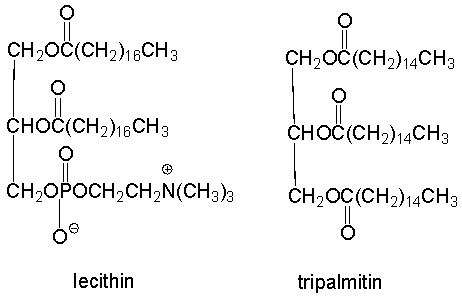

A) lecithin
B) tripalmitin
C) sodium lauryl sulfate
D) androsterone
E) carbohydrates


A) lecithin
B) tripalmitin
C) sodium lauryl sulfate
D) androsterone
E) carbohydrates

Unlock Deck
Unlock for access to all 123 flashcards in this deck.
Unlock Deck
k this deck
10
______lipids do not undergo hydrolysis in the presence of aqueous acid or base.

Unlock Deck
Unlock for access to all 123 flashcards in this deck.
Unlock Deck
k this deck
11
Which one of the following is a class of complex lipids?
A) steroids
B) terpenes
C) waxes
D) prostaglandins
E) furans
A) steroids
B) terpenes
C) waxes
D) prostaglandins
E) furans

Unlock Deck
Unlock for access to all 123 flashcards in this deck.
Unlock Deck
k this deck
12
Which of the following is a structure of a wax? 

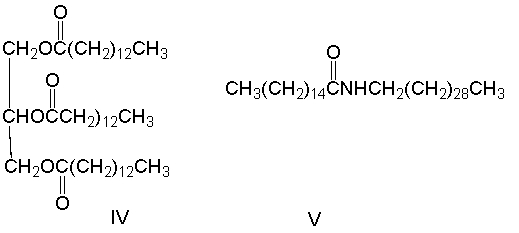
A) I
B) II
C) III
D) IV
E) V



A) I
B) II
C) III
D) IV
E) V

Unlock Deck
Unlock for access to all 123 flashcards in this deck.
Unlock Deck
k this deck
13
The following compound is best classified as a(n) _________. 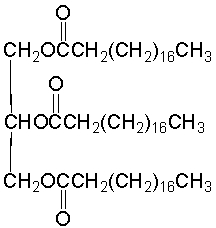
A) simple lipid
B) fat
C) cephalin
D) wax
E) oil

A) simple lipid
B) fat
C) cephalin
D) wax
E) oil

Unlock Deck
Unlock for access to all 123 flashcards in this deck.
Unlock Deck
k this deck
14
Which one of the following is a class of simple lipids?
A) steroids
B) triglycerides
C) phoshpholipids
D) waxes
E) furans
A) steroids
B) triglycerides
C) phoshpholipids
D) waxes
E) furans

Unlock Deck
Unlock for access to all 123 flashcards in this deck.
Unlock Deck
k this deck
15
Which of the following is not a class of complex lipids?
A) waxes
B) prostaglandins
C) triglycerides
D) phospholipids
A) waxes
B) prostaglandins
C) triglycerides
D) phospholipids

Unlock Deck
Unlock for access to all 123 flashcards in this deck.
Unlock Deck
k this deck
16
Predict the products when triacontyl hexadecanoate, a major component of beeswax is treated with aqueous NaOH. 




A) I
B) II
C) III
D) IV
E) none of these





A) I
B) II
C) III
D) IV
E) none of these

Unlock Deck
Unlock for access to all 123 flashcards in this deck.
Unlock Deck
k this deck
17
Predict the products when spermaceti is treated with aqueous NaOH. 




A) I
B) II
C) III
D) IV
E) none of these





A) I
B) II
C) III
D) IV
E) none of these

Unlock Deck
Unlock for access to all 123 flashcards in this deck.
Unlock Deck
k this deck
18
Which of the following is a correct description of waxes?
A) long chain esters
B) long chain ethers
C) long chain anhydrides
D) long chain fatty acids
E) long chain alcohols
A) long chain esters
B) long chain ethers
C) long chain anhydrides
D) long chain fatty acids
E) long chain alcohols

Unlock Deck
Unlock for access to all 123 flashcards in this deck.
Unlock Deck
k this deck
19
Insects have a protective coating of wax on their _____________.
A) exoskeleton
B) antenna
C) legs
D) eyes
E) hair
A) exoskeleton
B) antenna
C) legs
D) eyes
E) hair

Unlock Deck
Unlock for access to all 123 flashcards in this deck.
Unlock Deck
k this deck
20
______lipids undergo hydrolysis in the presence of aqueous acid or base.

Unlock Deck
Unlock for access to all 123 flashcards in this deck.
Unlock Deck
k this deck
21
Predict the product for the following reaction. 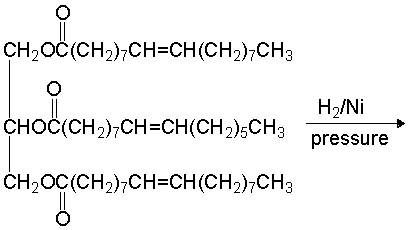


Unlock Deck
Unlock for access to all 123 flashcards in this deck.
Unlock Deck
k this deck
22
The following compound is best classified as a(n) _________. 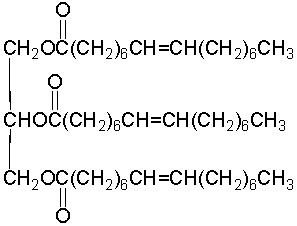
A) simple lipid
B) fat
C) cephalin
D) wax
E) oil

A) simple lipid
B) fat
C) cephalin
D) wax
E) oil

Unlock Deck
Unlock for access to all 123 flashcards in this deck.
Unlock Deck
k this deck
23
Which one of the following is classified as an oil?
A) trilaurin
B) trilinolein
C) tripalmitin
D) triarchadin
A) trilaurin
B) trilinolein
C) tripalmitin
D) triarchadin

Unlock Deck
Unlock for access to all 123 flashcards in this deck.
Unlock Deck
k this deck
24
Which one of the following fatty acids has the highest melting point?
A) oleic acid
B) linoleic acid
C) palmitoleic acid
D) arachidonic acid
E) arachidic acid
A) oleic acid
B) linoleic acid
C) palmitoleic acid
D) arachidonic acid
E) arachidic acid

Unlock Deck
Unlock for access to all 123 flashcards in this deck.
Unlock Deck
k this deck
25
The following compound is best classified as a(n) _________. 
A) simple lipid
B) unsaturated triglyceride
C) unsaturated fatty acid
D) fat
E) wax

A) simple lipid
B) unsaturated triglyceride
C) unsaturated fatty acid
D) fat
E) wax

Unlock Deck
Unlock for access to all 123 flashcards in this deck.
Unlock Deck
k this deck
26
Which of the following reagent(s) would convert palmitoleic acid to palmitic acid?
A) NaBH4/CH3OH
B) 1. LiAlH4, 2. H2O
C) NaOH/H2O heat
D) H2/Ni
E) A and B
A) NaBH4/CH3OH
B) 1. LiAlH4, 2. H2O
C) NaOH/H2O heat
D) H2/Ni
E) A and B

Unlock Deck
Unlock for access to all 123 flashcards in this deck.
Unlock Deck
k this deck
27
The following compound is best classified as an _________. 
A) simple lipid
B) saturated triglyceride
C) saturated fatty acid
D) fat
E) wax

A) simple lipid
B) saturated triglyceride
C) saturated fatty acid
D) fat
E) wax

Unlock Deck
Unlock for access to all 123 flashcards in this deck.
Unlock Deck
k this deck
28
How many different structures (including stereoisomers) are possible for a triglyceride that contains two palmitic acid residues and one stearic acid residue?
A) 1
B) 2
C) 3
D) 4
E) 5
A) 1
B) 2
C) 3
D) 4
E) 5

Unlock Deck
Unlock for access to all 123 flashcards in this deck.
Unlock Deck
k this deck
29
Predict the product for the following reaction. 


Unlock Deck
Unlock for access to all 123 flashcards in this deck.
Unlock Deck
k this deck
30
Which of the following fatty acids is not likely to occur in a natural source?
A) octadecanoic acid
B) hexadecanoic acid
C) (Z)-9-hexadecenoic acid
D) pentadecanoic acid
E) (Z)-11-tetradecenoic acid
A) octadecanoic acid
B) hexadecanoic acid
C) (Z)-9-hexadecenoic acid
D) pentadecanoic acid
E) (Z)-11-tetradecenoic acid

Unlock Deck
Unlock for access to all 123 flashcards in this deck.
Unlock Deck
k this deck
31
Which one of the following has the lowest melting point? 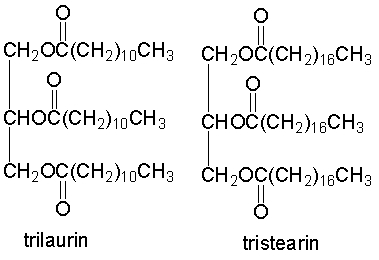
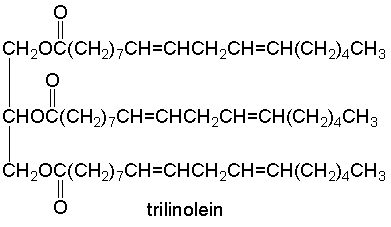
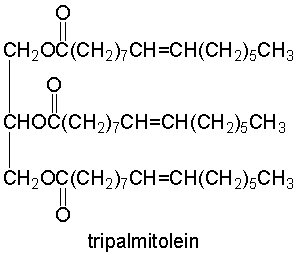
A) trilaurin
B) tristearin
C) trilinolein
D) tripalmitolein



A) trilaurin
B) tristearin
C) trilinolein
D) tripalmitolein

Unlock Deck
Unlock for access to all 123 flashcards in this deck.
Unlock Deck
k this deck
32
Which one of the following fatty acids has the lowest melting point?
A) stearic acid
B) palmitic acid
C) lauric acid
D) arachidic acid
E) myristic acid
A) stearic acid
B) palmitic acid
C) lauric acid
D) arachidic acid
E) myristic acid

Unlock Deck
Unlock for access to all 123 flashcards in this deck.
Unlock Deck
k this deck
33
Which one of the following fatty acids has the lowest melting point?
A) oleic acid
B) linoleic acid
C) palmitoleic acid
D) arachidonic acid
E) arachidic acid
A) oleic acid
B) linoleic acid
C) palmitoleic acid
D) arachidonic acid
E) arachidic acid

Unlock Deck
Unlock for access to all 123 flashcards in this deck.
Unlock Deck
k this deck
34
Which of the following fatty acids are most likely to occur in a natural source? 




A) I and III
B) I, III and IV
C) II and V
D) IV and V
E) I, III, IV and V





A) I and III
B) I, III and IV
C) II and V
D) IV and V
E) I, III, IV and V

Unlock Deck
Unlock for access to all 123 flashcards in this deck.
Unlock Deck
k this deck
35
Which one of the following is classified as a fat?
A) triolein
B) trilinolein
C) tripalmitolein
D) triarchadin
A) triolein
B) trilinolein
C) tripalmitolein
D) triarchadin

Unlock Deck
Unlock for access to all 123 flashcards in this deck.
Unlock Deck
k this deck
36
Which one of the following fatty acids has the highest melting point?
A) stearic acid
B) palmitic acid
C) lauric acid
D) arachidic acid
E) oleic acid
A) stearic acid
B) palmitic acid
C) lauric acid
D) arachidic acid
E) oleic acid

Unlock Deck
Unlock for access to all 123 flashcards in this deck.
Unlock Deck
k this deck
37
Arrange the following compounds in decreasing order of melting point. 

A) II > I > IV > III
B) III > IV > I > II
C) IV > I > II > III
D) III > II > IV > I
E) I > II > IV > III


A) II > I > IV > III
B) III > IV > I > II
C) IV > I > II > III
D) III > II > IV > I
E) I > II > IV > III

Unlock Deck
Unlock for access to all 123 flashcards in this deck.
Unlock Deck
k this deck
38
Which of the following fatty acid(s) is not likely to be present in natural fats and oils?
A) octadecanoic acid
B) heptadecanoic acid
C) hexadecanoic acid
D) octadeca-9,12-dienoic acid
E) none of these
A) octadecanoic acid
B) heptadecanoic acid
C) hexadecanoic acid
D) octadeca-9,12-dienoic acid
E) none of these

Unlock Deck
Unlock for access to all 123 flashcards in this deck.
Unlock Deck
k this deck
39
Which one of the following has the highest melting point? 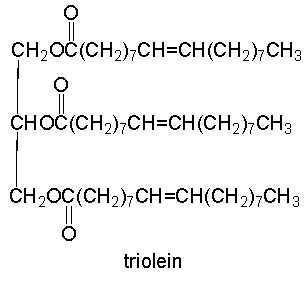
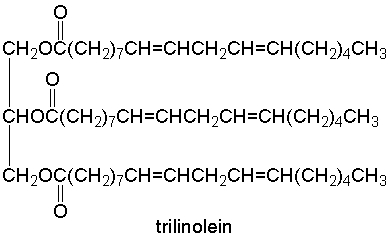
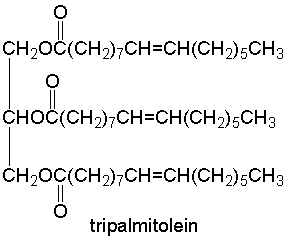
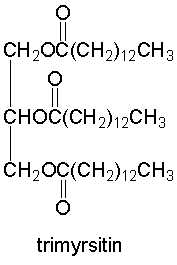
A) triolein
B) trilinolein
C) tripalmitolein
D) trimyrisitin




A) triolein
B) trilinolein
C) tripalmitolein
D) trimyrisitin

Unlock Deck
Unlock for access to all 123 flashcards in this deck.
Unlock Deck
k this deck
40
Which one of the following fatty acids is produced when oleic acid is hydrogenated? 
A) palmitic acid
B) lauric acid
C) myrsitic acid
D) arachidic acid
E) stearic acid

A) palmitic acid
B) lauric acid
C) myrsitic acid
D) arachidic acid
E) stearic acid

Unlock Deck
Unlock for access to all 123 flashcards in this deck.
Unlock Deck
k this deck
41
Predict the product(s) for the following reaction. 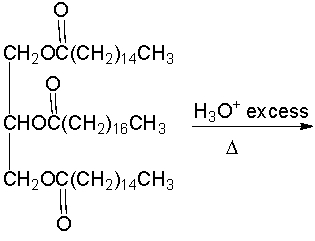


Unlock Deck
Unlock for access to all 123 flashcards in this deck.
Unlock Deck
k this deck
42
What are the ions that are typically in soap scum?
A) sodium and potassium
B) lithium and potassium
C) hydroxide and nitrate
D) calcium and magnesium
E) silver and tin
A) sodium and potassium
B) lithium and potassium
C) hydroxide and nitrate
D) calcium and magnesium
E) silver and tin

Unlock Deck
Unlock for access to all 123 flashcards in this deck.
Unlock Deck
k this deck
43
Which of the following compounds is (are) used as a detergent? 

A) I
B) II
C) III
D) IV
E) V


A) I
B) II
C) III
D) IV
E) V

Unlock Deck
Unlock for access to all 123 flashcards in this deck.
Unlock Deck
k this deck
44
The reaction of triglycerides with a base is a(n) ________ reaction.
A) esterification
B) transesterification
C) saponification
D) autooxidation
E) oxidation
A) esterification
B) transesterification
C) saponification
D) autooxidation
E) oxidation

Unlock Deck
Unlock for access to all 123 flashcards in this deck.
Unlock Deck
k this deck
45
A triglyceride produced a linoleic acid residue, a palmitoleic acid residue and an oleic acid residue, when heated in the presence of an acid. Provide one of the possible structures for this triglyceride.

Unlock Deck
Unlock for access to all 123 flashcards in this deck.
Unlock Deck
k this deck
46
Predict the product(s) for the following reaction. 


Unlock Deck
Unlock for access to all 123 flashcards in this deck.
Unlock Deck
k this deck
47
An optically inactive triglyceride produced two palmitic acid residues and one oleic acid residue, when heated in the presence of an acid. Provide the structure(s) for this triglyceride. 
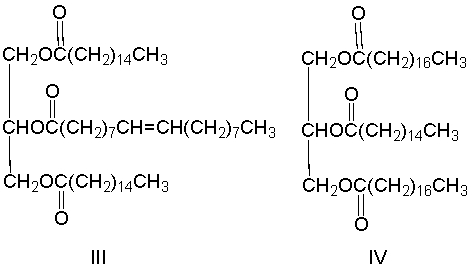
A) I
B) II
C) III
D) IV
E) B and C


A) I
B) II
C) III
D) IV
E) B and C

Unlock Deck
Unlock for access to all 123 flashcards in this deck.
Unlock Deck
k this deck
48
Predict the product(s) for the following reaction. 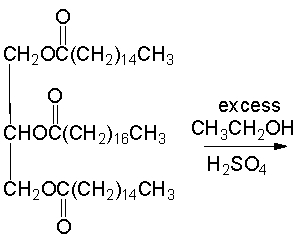


Unlock Deck
Unlock for access to all 123 flashcards in this deck.
Unlock Deck
k this deck
49
How many different structures (including stereoisomers) are possible for a triglyceride that contains one palmitic acid residue, one arachidic acid residue and one stearic acid residue?
A) 3
B) 6
C) 9
D) 12
E) 15
A) 3
B) 6
C) 9
D) 12
E) 15

Unlock Deck
Unlock for access to all 123 flashcards in this deck.
Unlock Deck
k this deck
50
Which of the following compounds is (are) used as a soap? 

A) I
B) II
C) III
D) IV
E) V


A) I
B) II
C) III
D) IV
E) V

Unlock Deck
Unlock for access to all 123 flashcards in this deck.
Unlock Deck
k this deck
51
The interior of a micelle is ______, whereas the exterior is _______.
A) hydrophilic, hydrophobic
B) hydrophilic, hydrophilic
C) hydrophobic, hydrophobic
D) hydrophobic, hydrophilic
A) hydrophilic, hydrophobic
B) hydrophilic, hydrophilic
C) hydrophobic, hydrophobic
D) hydrophobic, hydrophilic

Unlock Deck
Unlock for access to all 123 flashcards in this deck.
Unlock Deck
k this deck
52
Predict the product(s) for the following reaction. 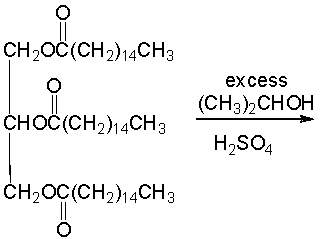


Unlock Deck
Unlock for access to all 123 flashcards in this deck.
Unlock Deck
k this deck
53
The rancid smell from unsaturated oils is due to ______________.
A) the reduction of the ester group
B) the oxidation of the ester group
C) the oxidation of the alkene
D) the reduction of the alkene
E) autooxidation
A) the reduction of the ester group
B) the oxidation of the ester group
C) the oxidation of the alkene
D) the reduction of the alkene
E) autooxidation

Unlock Deck
Unlock for access to all 123 flashcards in this deck.
Unlock Deck
k this deck
54
Unsaturated triglycerides undergo autooxidation at the ___________ position of the fatty acid residue.
A) vinylic
B) allylic
C) gamma
D) delta
E) next to carbonyl
A) vinylic
B) allylic
C) gamma
D) delta
E) next to carbonyl

Unlock Deck
Unlock for access to all 123 flashcards in this deck.
Unlock Deck
k this deck
55
An optically active triglyceride produced two palmitic acid residues and one oleic acid residue, when heated in the presence of an acid. Provide the structure(s) for this triglyceride. 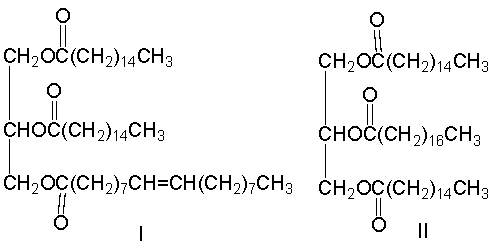
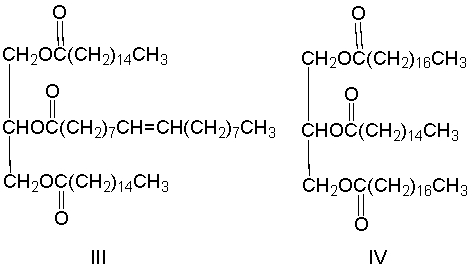
A) I
B) II
C) III
D) IV
E) B and C


A) I
B) II
C) III
D) IV
E) B and C

Unlock Deck
Unlock for access to all 123 flashcards in this deck.
Unlock Deck
k this deck
56
Identify the substance that has a hydrophobic group and a hydrophilic group, but the ion exchange reaction does not generate a precipitate.
A) detergent
B) soap
C) cooking oil
D) kerosene
E) biodiesel
A) detergent
B) soap
C) cooking oil
D) kerosene
E) biodiesel

Unlock Deck
Unlock for access to all 123 flashcards in this deck.
Unlock Deck
k this deck
57
Provide the structure of an optically active triglyceride that produced two myristic acid residues and an oleic acid residue when heated in the presence of an acid.

Unlock Deck
Unlock for access to all 123 flashcards in this deck.
Unlock Deck
k this deck
58
Identify the substance that can be made from heating animal fat with wood ashes, which contain alkaline substances.
A) detergent
B) soap
C) cooking oil
D) kerosene
E) biodiesel
A) detergent
B) soap
C) cooking oil
D) kerosene
E) biodiesel

Unlock Deck
Unlock for access to all 123 flashcards in this deck.
Unlock Deck
k this deck
59
Identify the fuel that is produced when vegetable oil undergoes transesterification.
A) gasoline
B) diesel
C) biodiesel
D) kerosene
E) natural gas
A) gasoline
B) diesel
C) biodiesel
D) kerosene
E) natural gas

Unlock Deck
Unlock for access to all 123 flashcards in this deck.
Unlock Deck
k this deck
60
In the presence of molecular oxygen, saturated triglycerides undergo autooxidation to yield hydroperoxides.
A) true
B) false
A) true
B) false

Unlock Deck
Unlock for access to all 123 flashcards in this deck.
Unlock Deck
k this deck
61
Explain why fatty acids cannot form a bilayer.

Unlock Deck
Unlock for access to all 123 flashcards in this deck.
Unlock Deck
k this deck
62
Which of the following is a correct description of the following compound? 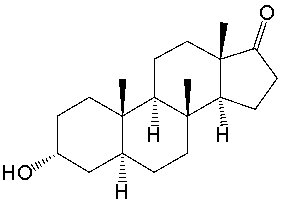
A) triglyceride
B) steroid
C) phospholipid
D) prostaglandin
E) terpene

A) triglyceride
B) steroid
C) phospholipid
D) prostaglandin
E) terpene

Unlock Deck
Unlock for access to all 123 flashcards in this deck.
Unlock Deck
k this deck
63
Predict the product when cholesterol is treated with acetyl chloride in presence of pyridine. 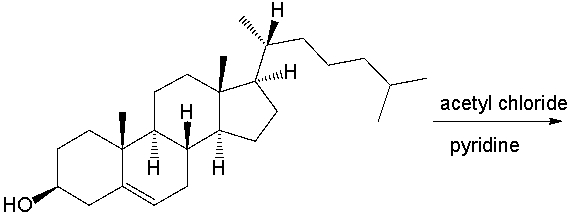


Unlock Deck
Unlock for access to all 123 flashcards in this deck.
Unlock Deck
k this deck
64
Which of the following compounds is a phosphatidic acid? 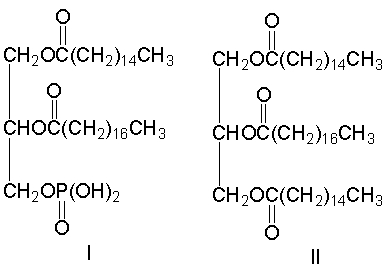
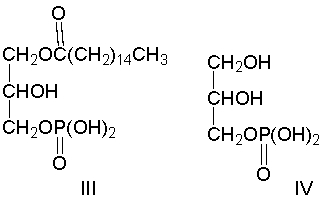
A) I
B) II
C) III
D) IV
E) none of these


A) I
B) II
C) III
D) IV
E) none of these

Unlock Deck
Unlock for access to all 123 flashcards in this deck.
Unlock Deck
k this deck
65
Phosphoglycerides that contain ethanolamine are called_____.
A) lecithins
B) phosphatidyl serines
C) plasmalogens
D) cephalins
E) biodiesel
A) lecithins
B) phosphatidyl serines
C) plasmalogens
D) cephalins
E) biodiesel

Unlock Deck
Unlock for access to all 123 flashcards in this deck.
Unlock Deck
k this deck
66
A lipid bilayer is formed by the self assembly of _________.
A) triglycerides
B) saturated fatty acids
C) phosphoglycerides
D) unsaturated fatty acids
E) alcohols
A) triglycerides
B) saturated fatty acids
C) phosphoglycerides
D) unsaturated fatty acids
E) alcohols

Unlock Deck
Unlock for access to all 123 flashcards in this deck.
Unlock Deck
k this deck
67
In estrone the B-C ring fusion is ______and the C-D ring fusion is ______. 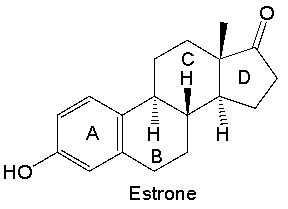
A) cis, trans
B) cis, cis
C) trans, cis
D) trans, trans
E) both cis and trans, both cis and trans

A) cis, trans
B) cis, cis
C) trans, cis
D) trans, trans
E) both cis and trans, both cis and trans

Unlock Deck
Unlock for access to all 123 flashcards in this deck.
Unlock Deck
k this deck
68
Which of the following lipids would produce two fatty acid residues along with choline on hydrolysis?
A) cephalins
B) phosphatidyl serines
C) triolein
D) lecithins
E) phospholipid
A) cephalins
B) phosphatidyl serines
C) triolein
D) lecithins
E) phospholipid

Unlock Deck
Unlock for access to all 123 flashcards in this deck.
Unlock Deck
k this deck
69
Phosphoglycerides that contain choline are called_____.
A) lecithins
B) phosphatidyl serines
C) plasmalogens
D) cephalins
E) biodiesel
A) lecithins
B) phosphatidyl serines
C) plasmalogens
D) cephalins
E) biodiesel

Unlock Deck
Unlock for access to all 123 flashcards in this deck.
Unlock Deck
k this deck
70
Provide the structure of a lecithin that would produce two stearic acid residues on hydrolysis?

Unlock Deck
Unlock for access to all 123 flashcards in this deck.
Unlock Deck
k this deck
71
In naturally occurring steroids mostly the B-C ring fusion is ______and the C-D ring fusion is ______.
A) cis, trans
B) cis, cis
C) trans, cis
D) trans, trans
E) both cis and trans, both cis and trans
A) cis, trans
B) cis, cis
C) trans, cis
D) trans, trans
E) both cis and trans, both cis and trans

Unlock Deck
Unlock for access to all 123 flashcards in this deck.
Unlock Deck
k this deck
72
In androsterone the A-B ring fusion is ______and the B-C ring fusion is ______. 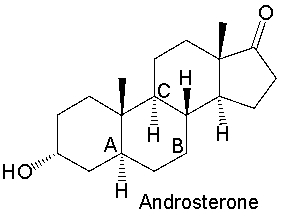
A) cis, trans
B) cis, cis
C) trans, cis
D) trans, trans
E) both cis and trans, both cis and trans

A) cis, trans
B) cis, cis
C) trans, cis
D) trans, trans
E) both cis and trans, both cis and trans

Unlock Deck
Unlock for access to all 123 flashcards in this deck.
Unlock Deck
k this deck
73
List the components of lechithins and cephalins.
A) three polar head groups
B) two polar head groups and one nonpolar hydrophobic tail
C) one polar head group and two nonpolar hydrophobic tails
D) three nonpolar hydrophobic tails
A) three polar head groups
B) two polar head groups and one nonpolar hydrophobic tail
C) one polar head group and two nonpolar hydrophobic tails
D) three nonpolar hydrophobic tails

Unlock Deck
Unlock for access to all 123 flashcards in this deck.
Unlock Deck
k this deck
74
Phosphoglycerides differ from triglycerides in that one of the three fatty acid residues is replaced by a(n) ______ group.
A) thioester
B) phosphoester
C) thiol
D) alcohol
E) ester
A) thioester
B) phosphoester
C) thiol
D) alcohol
E) ester

Unlock Deck
Unlock for access to all 123 flashcards in this deck.
Unlock Deck
k this deck
75
Which of the following is the structure of a cephalin that would produce one equivalent of oleic acid and one equivalent of stearic acid residues on hydrolysis? 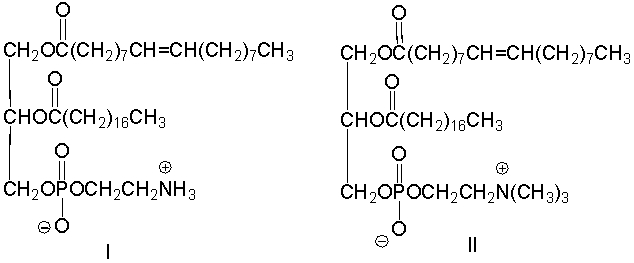
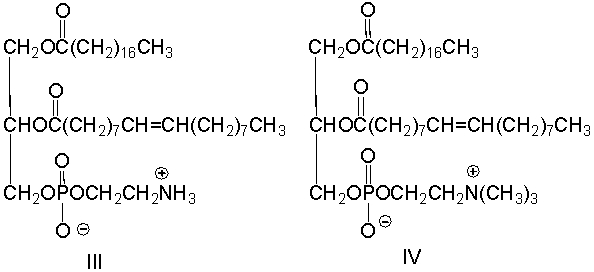
A) I
B) II
C) III
D) I and III
E) II and IV


A) I
B) II
C) III
D) I and III
E) II and IV

Unlock Deck
Unlock for access to all 123 flashcards in this deck.
Unlock Deck
k this deck
76
Provide the structure of a cephalin that would produce two oleic acid residues on hydrolysis?

Unlock Deck
Unlock for access to all 123 flashcards in this deck.
Unlock Deck
k this deck
77
Which of the following lipids would produce two fatty acid residues along with ethanolamine on hydrolysis?
A) cephalins
B) phosphatidyl serines
C) triolein
D) lecithins
E) phospholipid
A) cephalins
B) phosphatidyl serines
C) triolein
D) lecithins
E) phospholipid

Unlock Deck
Unlock for access to all 123 flashcards in this deck.
Unlock Deck
k this deck
78
Why is decanol more efficient at crossing the cell membrane than hexanol?

Unlock Deck
Unlock for access to all 123 flashcards in this deck.
Unlock Deck
k this deck
79
Which of the following is a correct numbering of the steroid nucleus? 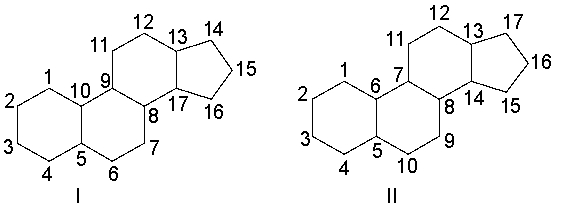
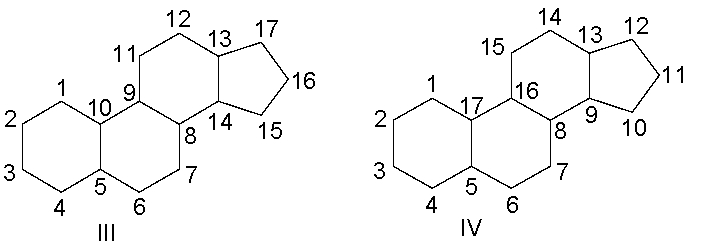
A) I
B) II
C) III
D) IV
E) none of these


A) I
B) II
C) III
D) IV
E) none of these

Unlock Deck
Unlock for access to all 123 flashcards in this deck.
Unlock Deck
k this deck
80
Identify a phosphatidic acid.
A) phosphoric acid
B) phosphoric acid monoester
C) phosphoric acid diester
D) phosphoric acid trimester
A) phosphoric acid
B) phosphoric acid monoester
C) phosphoric acid diester
D) phosphoric acid trimester

Unlock Deck
Unlock for access to all 123 flashcards in this deck.
Unlock Deck
k this deck



